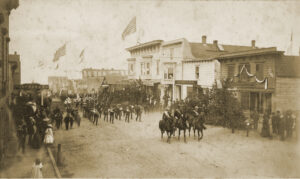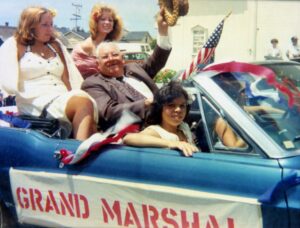The 2020 Fourth of July will not be the celebration we were hoping for. The expected parade along thronged streets, and the music-filled lawn party in front of the Kelley House – enjoyed by hundreds for more than 30 years – has been cancelled for public health reasons. We will have to celebrate our country’s birthday in other, less crowded ways.

One thing that we can still do is fly our flags. For some time, the Museum has wanted to replace its old wind-tattered one. The up-coming Fourth seems to be a good time to hoist a fresh flag up our liberty pole.
Our what? A liberty pole is what they used to call flag poles around here. Apparently, there’s quite a tradition for this, dating back to the liberation of the Roman Republic by the death of its tyrant, Julius Caesar. In our Revolutionary War era colonists would use them to show their defiance and proclaim liberty from England and her oppressive ways. During earlier times, liberty poles were usually topped with a loose-fitting cloth cap, and this type of pole has been depicted on statues, in paintings, and on coins for some two thousand years.
By the late 1800s, those caps had been set aside in the US and flagstaffs for flying the stars and stripes were just wooden poles made from straight tree trunks – and there were plenty of those around here. “In the number of its flags, Mendocino is indisputably the banner town of the county. No less than nine large flags were displayed on Main, between Lansing and Heeser streets,” boasted the Beacon in its June 6, 1885 edition.

The flags floating in our coastal breezes were stupendously large, making those hanging from present-day poles look like toy pennants. Antone Fernandez, owner of the Lisbon House hotel on Ukiah Street, had one of the biggest – a much-admired streamer that unfurled to 75 feet in length. Such a flag today would cover the tops of 5 cars lined up end to end.
Really tall poles were necessary to properly fly such enormous flags, and businessmen here competed to erect the tallest. The Lisbon House liberty pole was 110 feet high – as tall as an 11-story building! In a town where most structures topped out at three stories, the banners would have soared high, and when seen together they would have filled the sky.
Liberty poles were used on occasions other than holidays and the passing of noted statesmen. They were also lowered, touchingly, on the funeral days of beloved citizens. The Beacon reported on June 30, 1883, that “The flags in town were placed at half-mast on the day of Mrs. Dougherty’s funeral, a token of the esteem in which she was held in the community.”
At the shipping point out on Mendocino’s Headlands, the Lumber Company’s liberty pole had the additional function of signaling. Attended to on a daily basis, it conveyed messages for ships out at sea and flew storm warning flags. While we don’t know when the first of these Point poles was put up, a storm-damaged one was replaced in 1878 with a “106 ½ foot high pole.” The precise measurement mentioned in the newspaper report perhaps indicates just how important size was in this on-going competition.
Carlson’s City Hotel used their 100-foot pole for a different kind of signal – a lamp was hoisted to the top each evening, a beacon to the weary traveler.
For many years, flags were flown to commemorate Mendocino’s July 19, 1852 founding. “Pioneer J. E. Carlson had the stars and stripes floating from the liberty pole in front of his hotel yesterday in honor of the 37th anniversary of the landing of the pioneers of this place,” noted the Beacon in 1889.
Who else had liberty poles? Just about everyone. Kelley, another pioneer, had one topping out at 100 feet at his large store, located at the corner of Lansing and Main Streets. All the hotels, the post office, many saloons and stores, the high school and the grammar school, private homes, and even the Chinese Temple – all enthusiastically flew flags on their liberty poles. Some were planted in the ground, while others were affixed to the roofs or upper facades of buildings to get them ever higher.
So, when we think of Mendocino’s early skyline, already remarkable for its dozens of architectural water towers and whirling windmills, we should also imagine the flutter of its flags snapping in the wind.
Have a happy Fourth!